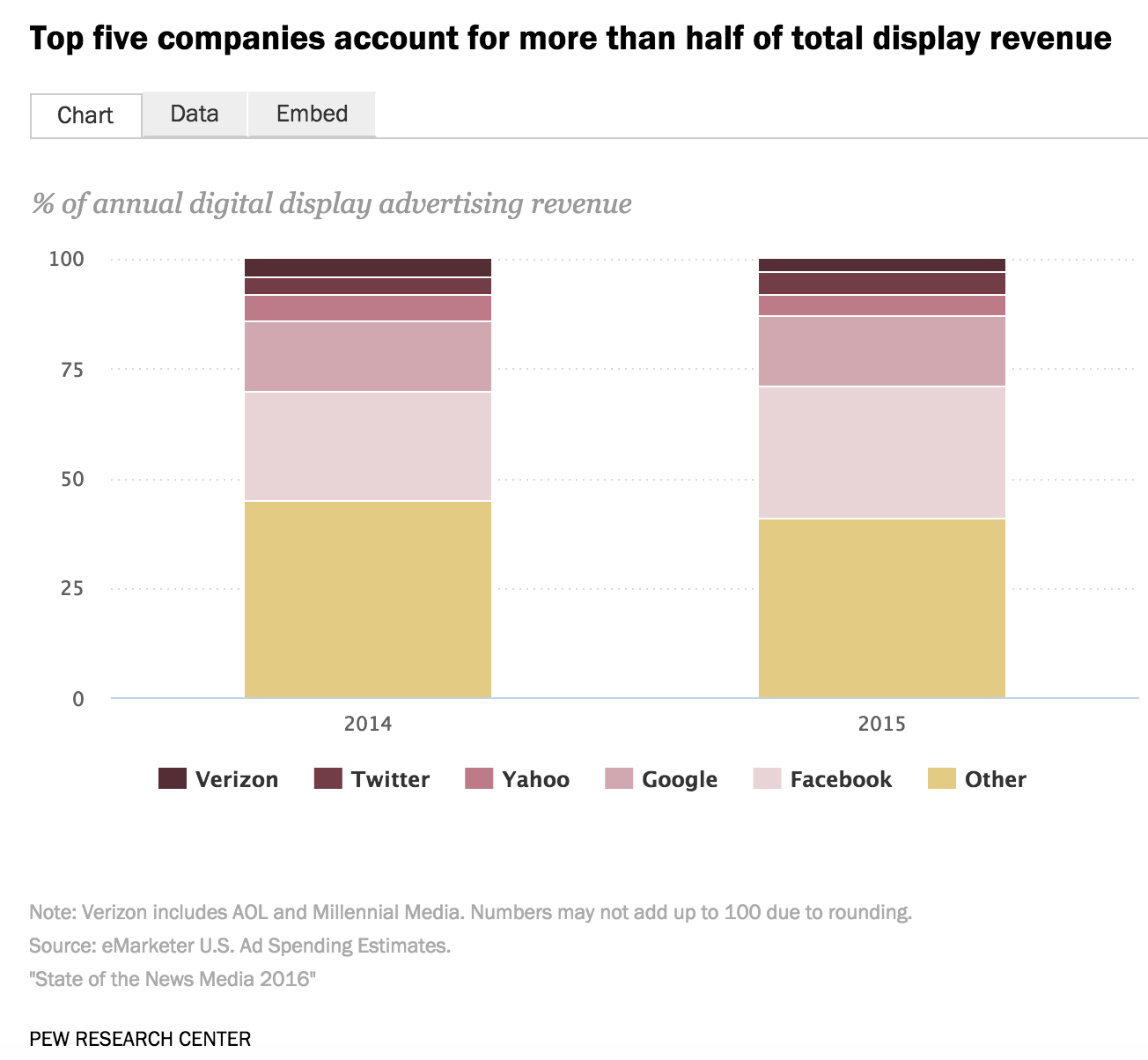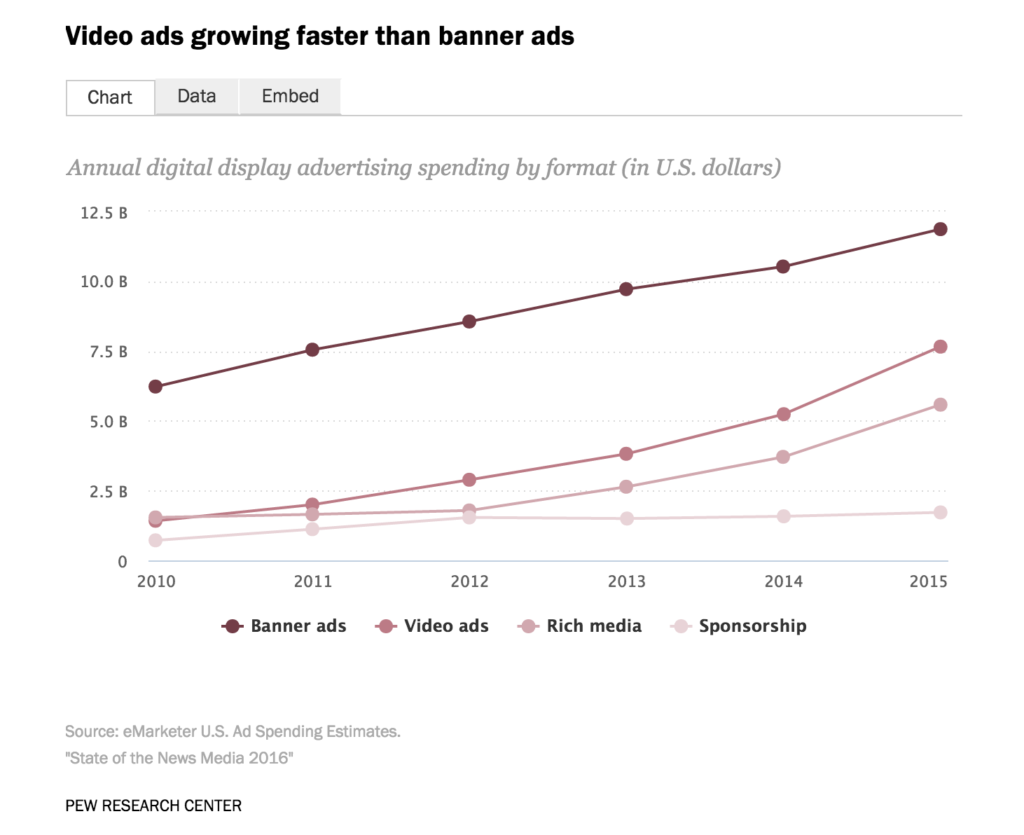Media
The State of Digital Media, in 5 Charts
‘Tis the season of reports in the digital content industry. With Mary Meeker’s “2016 Internet Trends” report, PageFair’s annual ad-blocking report, IAB’s quarterly revenue update, and Pew Research’s “State of the News Media” all coming out within the span of a few weeks, there has been a flood of information about the current state of the media, advertising, and marketing industries.
You probably don’t have time to read them all. Luckily, you have us. I already summed up the major takeaways from Mary Meeker’s internet trends report here, and I’ll quickly sum up the PageFair and IAB revenue updates in one sentence: Ad blocking is accelerating and going mobile, and digital ad revenue is growing quickly but it’s all going to Facebook and Google.
Pew Research’s “State of the News Media” report, however, is a bit more nuanced, mainly because it pulls from a large variety of sources (including Nielsen, comScore, eMarketer, SEC filings, and its own research). Here are the five major takeaways from the 17-page report.
1. The Big 5 are only getting bigger
Google, Facebook, Microsoft, Twitter, and Yahoo have dominated digital advertising for years, and they’re only getting more dominant. As you can see in the interactive chart above, the five companies make up the bulk of display ad revenue. Together, they account for 65 percent of total digital advertising revenues.
But increasingly, the Big 5 appears to be a misnomer. Judging by the past couple years, it’s more accurate to say that the digital ad industry is dominated by the Big 2: Facebook and Google.
Back in April, a Morgan Stanley analyst predicted that 85 percent of new ad spend online would go to either Facebook or Google. It was quite a prediction at the time, and the IAB’s quarterly revenue report came close to confirming his analysis.
math.
US digital ad market up ~$2.7B in Q1.
Google & Facebook swallowed ~$2B.
Rest of Internet $700 million. https://t.co/LRy9iY8TbH— Jason Kint (@jason_kint) June 10, 2016
As Jason Kint, CEO of the publisher trade group Digital Content Next, notes here, a whopping $2 billion of the new $2.7 billion in digital advertising revenue went to the two giants. That amounts to 74 percent of the total—not quite as dominant as the Morgan Stanley analyst expected, but still approaching duopoly status if the trend continues.
2. No one uses Snapchat Discover
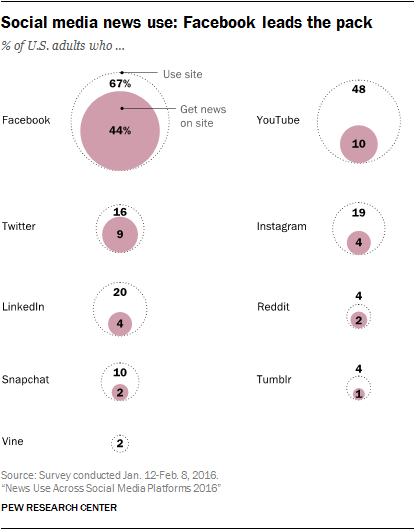
There has always been a lot of hype surrounding Snapchat. The ephemeral messaging app recently opened its advertising API to much fanfare—Adweek’s breathless cover story of the news called it a “colossal expansion” and a “new era” of the app—and everyone in advertising and publishing can’t seem to stop talking about its many promising features, including me.
But like all things in tech, hype is no guarantee for success. Despite the huge engagement numbers touted by publishers on Snapchat’s Discover feature—BuzzFeed CEO Jonah Perretti once said it made up 21 percent of the company’s traffic—Pew’s research suggests the numbers don’t add up.
According to its survey—which actually is from May but is referenced throughout the June report—only 2 percent of adults get their news from Snapchat. Compared to Facebook, the numbers are positively paltry. Perhaps Snapchat users don’t see Discover as “news” because of the unorthodox format, but even then it seems highly unlikely that a significant amount of people regularly use the feature.
3. Newspapers are officially niche
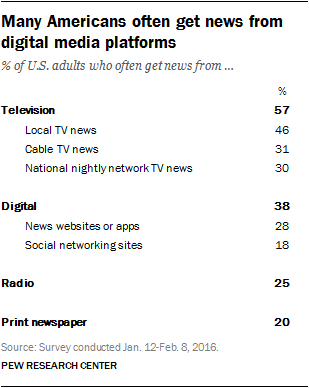
Alas, poor newspapers, we knew thee well.
A decade ago, 36 percent of Americans got most of their news from print newspapers. Now, that number has dropped all the way to 20 percent, while Americans relying on digital news sources has jumped up to 38 percent.
Meanwhile, both circulation and print revenue took a nosedive in the past year, enough for Pew to start their analysis of the newspaper industry by saying that 2015 “might as well have been a recession year.” Ouch.
There was some good news as The New York Times and The Washington Post both substantially grew their digital presences, but it’s safe to say that newspapers have officially been relegated to niche status, if they weren’t already. The more media buyers see this trend, the quicker print revenue will decline as ad budgets shift to digital. It’s a vicious cycle that will probably lead to many traditional newspaper companies either folding, consolidating, or undertaking risky business model pivots.
4. Native ads are stagnating
One revenue stream that isn’t helping most media companies is native advertising. What was once seen as something of a savior for plummeting revenues is no longer growing. Meanwhile, marketers have increased ad spend on just about every other form of ad revenue over the same period, most notably video advertising.
At the moment, native only accounts for 6 percent of total digital ad spending. It’s hard to say exactly why native advertising hasn’t taken off, though whispers of lackluster ROI and transparency issues may be the biggest deterrents.
5. Reddit is underrated, at least for news
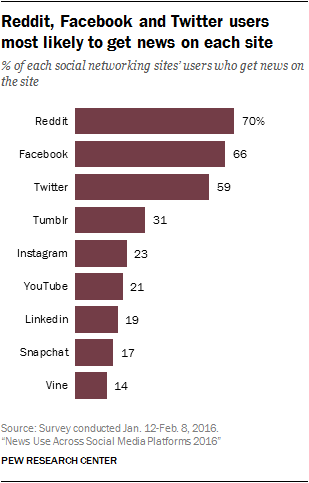
Often lost in all the talk about the digital news shift to social platforms is the power of Reddit. The so-called “front page of the internet” has something of an unsavory reputation due to scandals, but it also boasts a loyal core user base that relies on the platform to discover the latest news.
While every brand and media company seems to be creating specialized teams for Snapchat, Facebook, and other big-name platforms, it’s worth asking if their time could be better spent attempting to thrive on Reddit. It may not be as safe a space as the brand-friendly environs of Facebook or Snapchat, but the payoff could be huge.
Get better at your job right now.
Read our monthly newsletter to master content marketing. It’s made for marketers, creators, and everyone in between.
